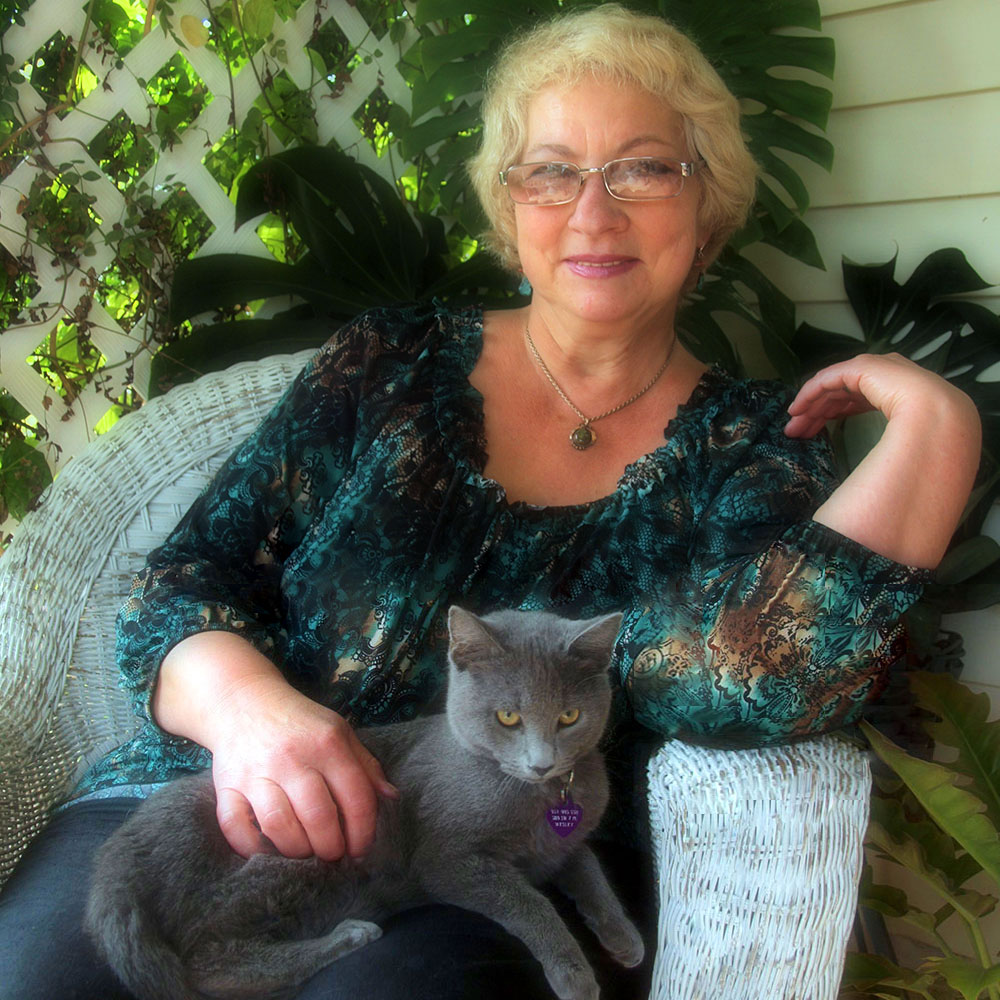Magnolia virginiana: a Native Virgin - Sweetbay Vanilla Magnolia
by Alex Butova, the Witch of Herbs and Cats
Alexandra Butova is our columnist, journalist, and photographer, living in Riga, Latvia. She has has been with TopTropicals since Day One (2002), writing about magic plants, travel, and of course cats - from the CatNation she belongs to. Alex is in charge of TopTropicals.ru website.
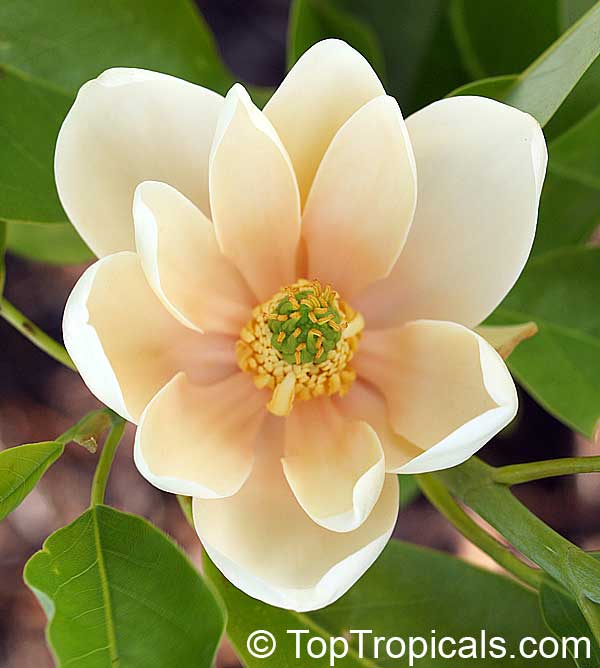
A Native Virgin - Sweetbay Vanilla Magnolia
...Fossilized specimens one of Magnolias have been found dating to 20 million years ago. Magnolia virginiana as a true American pioneer - it was the first magnolia to be scientifically described, and is thetype speciesof the genusMagnolia; asMagnoliais also thetype genusof allflowering plants(magnoliophytes), this species in a sense typifies all flowering plants. The flowers carry a very strong vanilla scent that can sometimes be noticed several hundred yards away! Fresh off the tree, the flavor of leaves is unique and fun to use. If you have a Florida Sweet Bay, your cooking will have flavors folks outside Florida can never hope to duplicate. It likes moist soils, so if you have a wet spot on your land - plant this tree. The lifespan of individual trees has been estimated at 130 years! No bugs, no pests!..
Magnolia flowers are rightfully considered a symbol of elegance. Exquisite smooth lines of flowers, as if carven of ivory and a delicate aroma, leave indifferent nobody.
But what do we know about these plants? Who are they and where are they from? To learn more, I invite you on a journey with one of these Elegant Ladies - a beautiful, slender, strong, invincible, a true American - Magnolia virginiana.
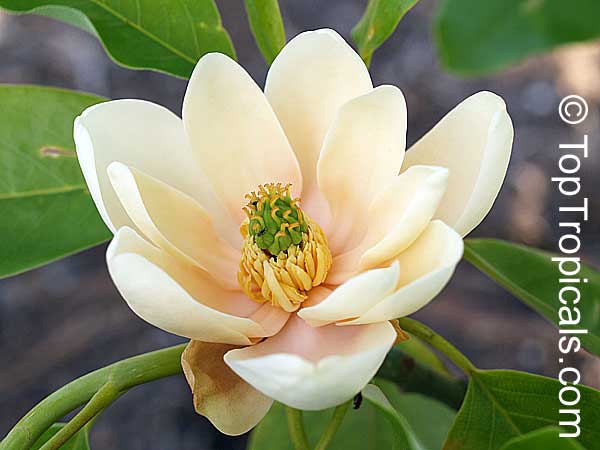
Magnolia virginiana, most commonly known asSweetbay Magnolia, also Laurel Magnolia, Swamp Magnolia, or Beaver Tree, is a member of theMagnoliafamily,Magnoliaceae. Magnoliasis a largegenus of about 210speciesof flowering plantnamed after French botanist Pierre Magnol. Fossilized specimens one of Magnolias have been found dating to 20 million years ago, and of plants identifiably belonging to the Magnoliaceae date to 95 million years ago. Nowadays the natural range ofMagnoliaspecies is adisjunct distribution, with a main center in east and southeastAsia and a secondary center in easternNorth America,Central America, theWest Indies, and some species inSouth America. Magnolias are also widely spread at the Mediterranean coast of Europe, the Caucuses Coast of the Black Sea and along the Coastal Asia Minor. Many magnolia species are relatively hardy, some up to Zone 7 or even 6. The hardy kinds grow wild in the Himalayas, Japan, China and North America. Tropical species of magnolias grow in tropical and subtropical climates (USDA zones 9-11).
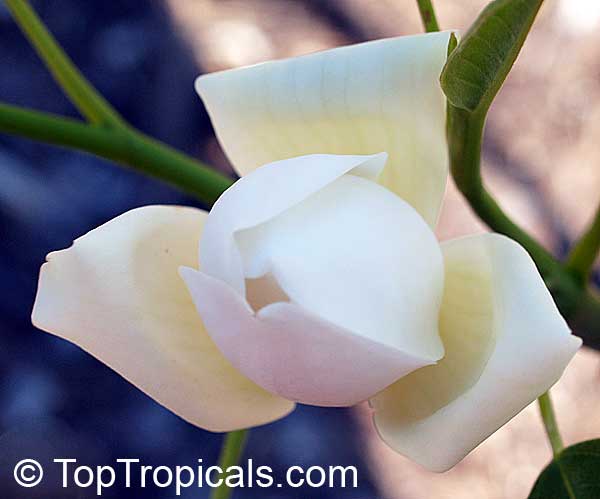
Magnolia virginiana as a true American pioneer - it was the first magnolia to be scientifically described under modern rules of botanicalnomenclature, and is thetype speciesof the genusMagnolia; asMagnoliais also thetype genusof allflowering plants(magnoliophytes), this species in a sense typifies all flowering plants.
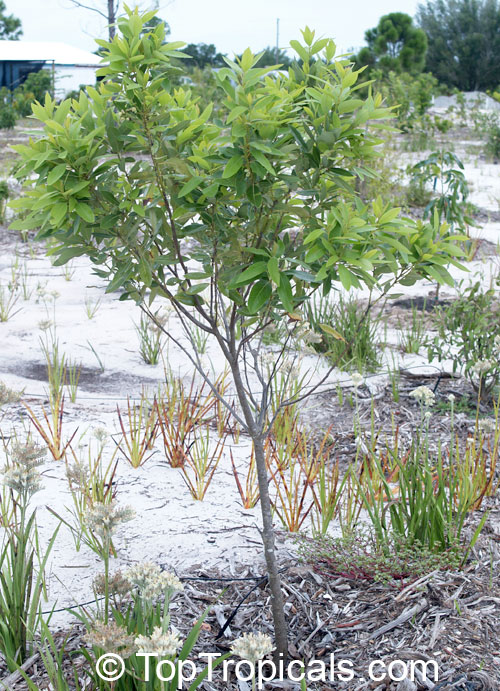
Magnolia virginianais native to the lowlands and swamps of the Atlantic coastal plain of the EasternUnited States, fromFloridatoLong Island,New York.
It is anevergreen to semi-deciduoustree. Whether it is deciduous or evergreen depends on climate; it is evergreen in areas with milder winters in the South of its range (Zone 7 southward), and is semi-evergreen or deciduous further North.
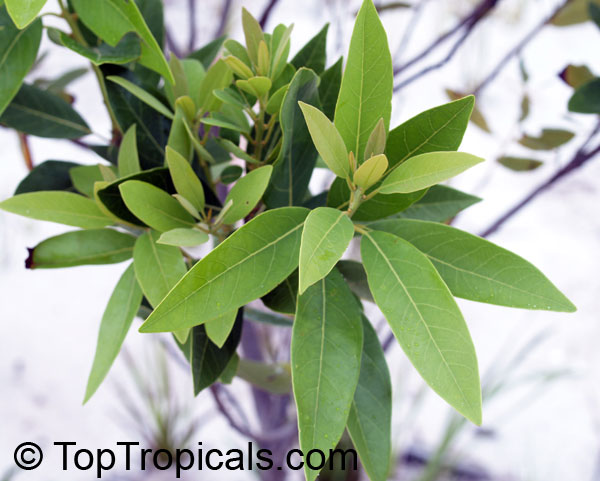
The leaves are alternate, simple (not lobed or pinnate), with entire margins, 3–6in long, and 1/2–2in wide. The bark is smooth and gray, with the inner bark mildly scented, the scent reminiscent of theBay Laurelspice (Laurus nobilis).
The flowers are creamy white, 3–7inin diameter, with 6-15 petal-like tepals. The flowers carry a very strong vanilla scent that can sometimes be noticed several hundred yards away!
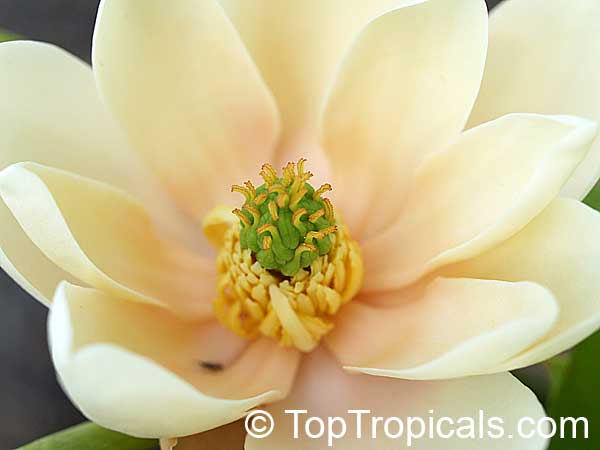
The fruit is a fused aggregate of follicles, 1-2in long, pinkish-red when mature, with the follicles splitting open to release the 1/2"long seeds. Theseedsare black but covered by a thinly fleshy red coat, which is attractive to somefruit-eatingbirds; these swallow the seeds, digest the red coating, and disperse the seeds in their droppings. Also seeds are dispersed by mammals, and by water and wind.
Sweetbay Magnolia is relatively important to various animals. The fruits, like other magnolias, are high in fat, and are eaten by gray squirrels, white-footed mice, turkey and quail as well as a variety of songbirds including vireos, towhees, Northern flicker and blue jays. In winter, deer and cattle browse the leaves, which are more tender than most broadleaf evergreens. The leaves are also used in the nests of several songbird species.
The spring shoots and leaves are important in the diet of the American black bear, and areas with Sweetbay Magnolia are important bear habitat. In the South, the species is also an important food for beavers, which eat the bark but rarely fell or girdle trees.
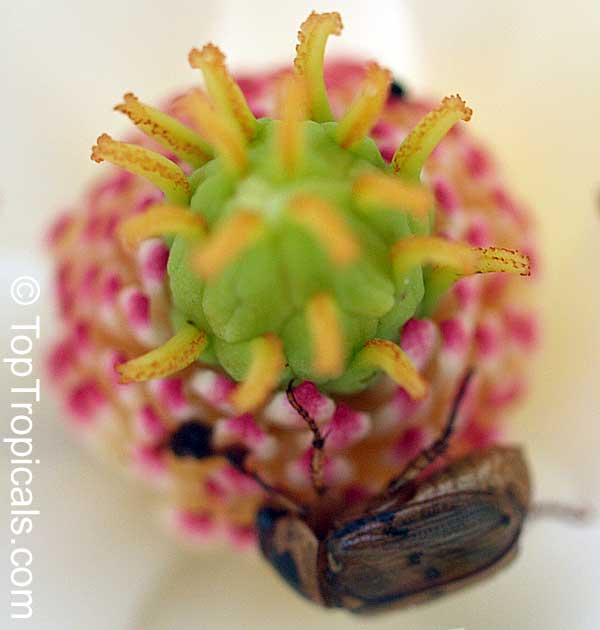
This plant also supports numerous butterflies and moths in their larval form, and numerous other insect.
Seedlings often establish under the canopy of other trees, including both hardwoods and conifers (usually pines). Growth however, is often best in sunny gaps or cleared areas. Young plants tolerate a narrower range of moisture conditions, and can be killed by flooding as well as drought. As trees mature, their tolerance of both flooding and drought increases.
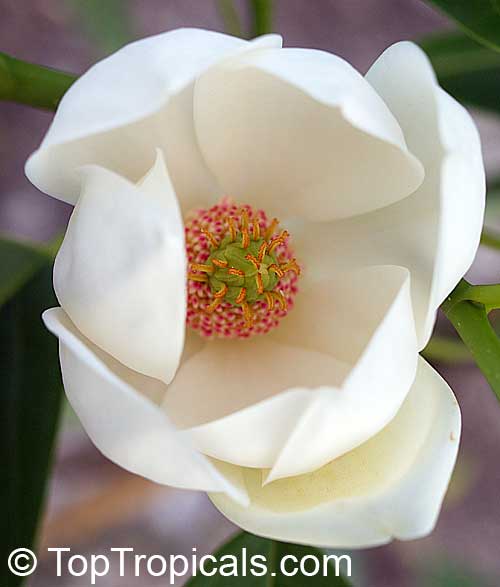
Naturally magnolias have compact crowns. They usually need little if any pruning unless you want to keep the plant very compact. If you do prune, however, do it soon after flowering to avoid cutting off buds set for the next season - this way you will provide enough time for the buds to form for the next flowering. It is recommended to cut crossing or rubbing branches and off-shoots preventing water and nutrients from reaching the top of the plant and distributing along the branches. Light pruning may be made even during winter time in order to clean branches from dry tips.
Fertile soil, rich of organic matter, regular watering and good drainage - that's all magnolia needs for a happy and long life. The lifespan of individual trees has been estimated at 130 years!
Magnolia virginianais often grown as an ornamental tree in gardens, and used in horticultural applications to give an architectural feel to landscape designs. It is an attractive tree for parks and largegardens, grown for its large, conspicuous, scented flowers, for its clean, attractive foliage, and for its fast growth. In Florida, it was used successfully in reclamation of a site used for phosphate mining... So it must be super easy to grow and not fussy!
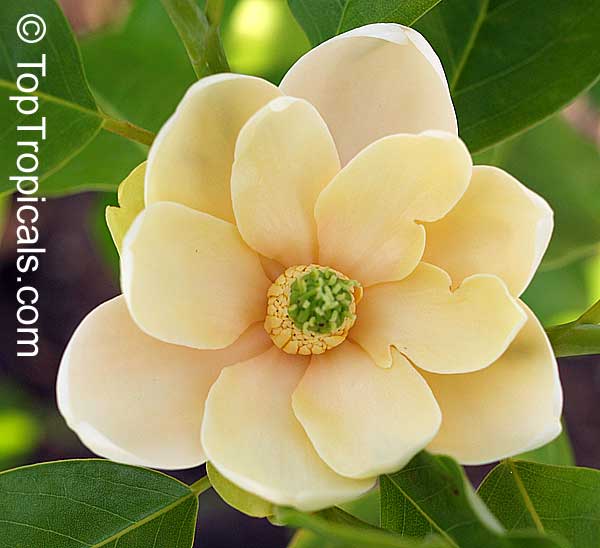
And it became a pioneer one more time!
This species was the first magnolia to be cultivated in England - the English botanist and missionaryJohn BanistercollectedMagnolia virginianain the southeastern United States in 1678 and sent it toEngland, where it flowered forBishop Henry Compton. Unfortunately, this beautiful American was soon overshadowed by evergreen, larger-flowered southern Magnolia grandiflora, which with more difficulty was adapted to the English climate.
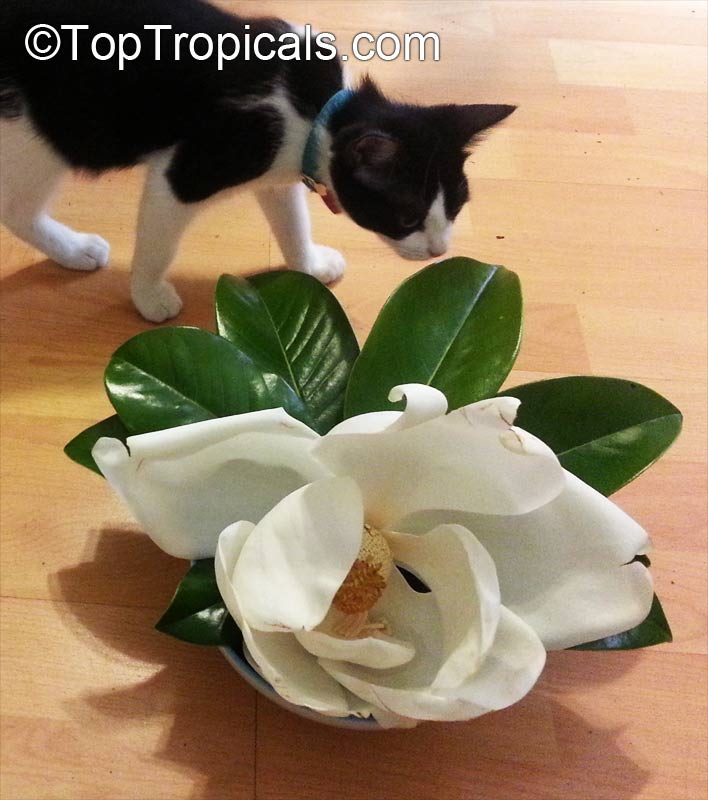
Nevertheless, in Europe Magnolia virginianahas been hybridizedhorticulturallywith a number of species withinsubgenus Magnolia. Some of these hybrids have been givencultivarnames and registered by the Magnolia Society.
Richard Figlar, the Scientific Advisor of Magnolia Society International, consulting Top Tropicals on Magnolia varieties (December 5, 2016)
Except Magnolia virginiana,there are seven otherMagnoliaspecies native to North America, and four introduced species. Among them areSouthern Magnolia (Magnolia grandiflora), Umbrella Tree (Magnolia tripetala),Pyramid Magnolia (Magnolia pyramidata), Bigleaf Magnolia (Magnolia macrophylla), andCucumber Tree (Magnolia acuminata).
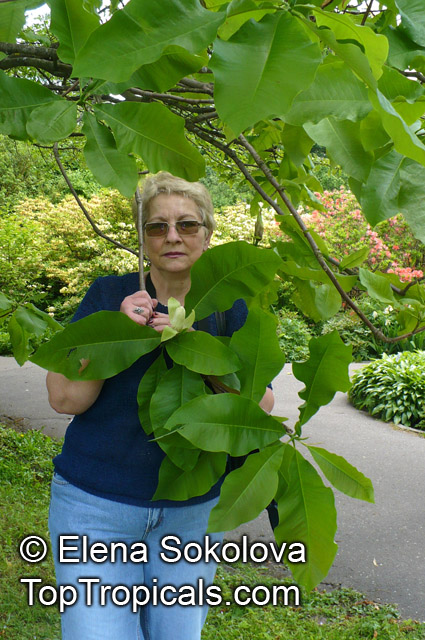
Magnolia tripetala - Umbrella Magnolia and the Author
After these, the next closest-related plant found in North America is the nativeTuliptree (Liriodendron tulipifera) - and they are all beautiful. Beautiful and elegant, of course! Nice company, isn't it? Take at least one of them home and enjoy!
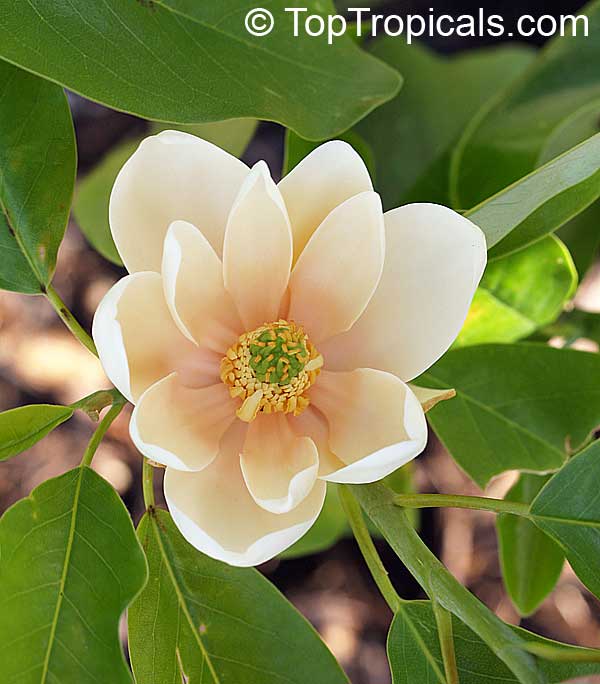
See more articles by Alex Butova


